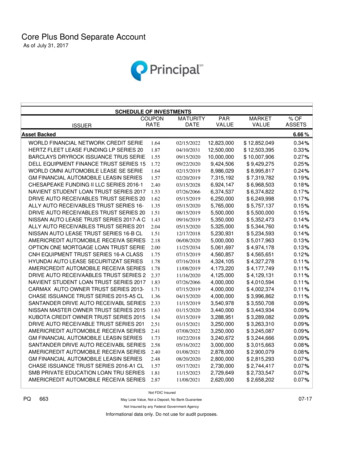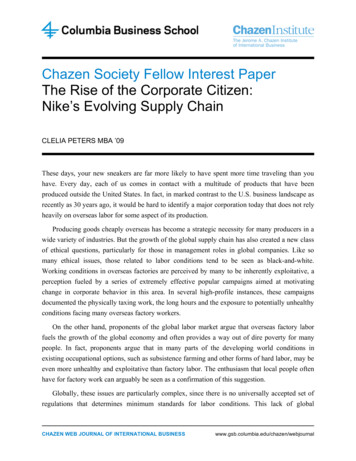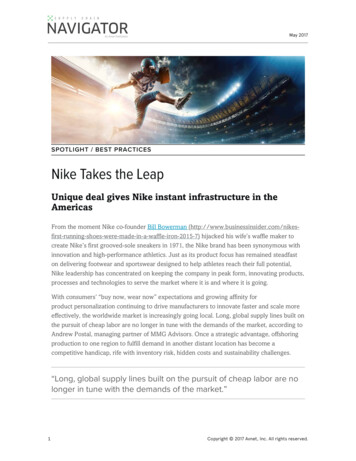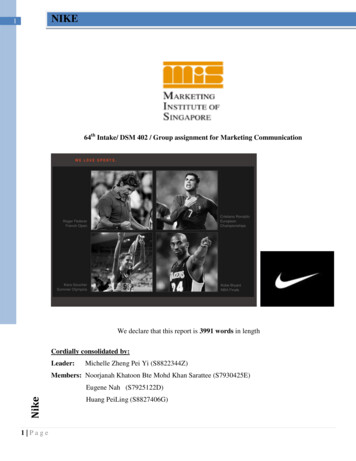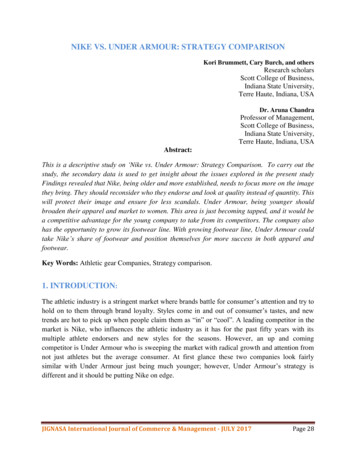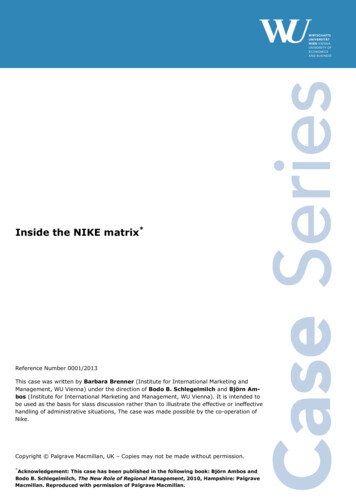
Transcription
101011010010101011010010101011010010A major research initiative at the MIT Sloan School of ManagementNike: From Separate Digital Initiativesto Firm-Level Transformation
Until recently,enterprising businessunits pursued digitalinitiatives in typical Nikefashion: launching theirown digital efforts tomeet specific needsNike is the world’s leadingdesigner, marketer and distributorof athletic footwear, apparel,equipment and accessories for awide range of sports and fitnessactivities. It is headquartered inBeaverton, Oregon, and employsabout 34,000 people around theworld. Founded in January 1964as “Blue Ribbon Sports,” thecompany created the Nike brandname and the Swoosh trademarkin 1971. Nike complementedits organic growth by acquiringsport apparel companies such asConverse in 2003 and Umbro in2007. As a major global brand,Nike has paid attention toemerging digital technologiesand innovations such as mobility,social media, analytics, and smartproducts since the late 1990s.Adopting digitaltechnologiesNike has traditionally built itsbusiness through a combinationof strong innovative products,intensive brand-building throughmultiple media, and efficientoperational processes. As thepossibilities of new digital mediaemerged, Nike was fast tocapitalize in all three areas. Untilrecently, enterprising businessunits pursued digital initiativesin typical Nike fashion: launchingtheir own digital efforts tomeet specific needs. Marketingembraced social media andthe firm started embeddingtechnology into products. ProductDevelopment embraced digitaldesign processes and enabledextensive collaboration across thesupply chain.Getting closer to always-moreconnected consumersNike’s social media strategy wasdriven by changes in the wayconsumers interact with brands.Nike’s Global Digital Brand andInnovation Director Jesse Stollakexplained, “the goal hasn’tchanged since the beginning ofNike — we want to connect withathletes to inspire and enablethem to be better. The rise of socialmedia provides new ways to dothis.” 1 To accompany that shift,Nike built dozens of social sitesdedicated to specific sports orproducts in Facebook and Twitter,and launched a presence in socialplatforms that dominated specificgeographies such as Orkut inBrazil, Weibo and RenRen in Chinaand VKontakte in Russia(see figure 1).Figure 1: Nike’s corporate presence in major social platforms all over the world (date: February 1st, 2012)Orkut (Brasil)Source: Nike, Capgemini Consulting analysis2RenRen (China)VKontakte (Russia)
In addition to joining public socialcommunities, Nike developed itsown social offerings for the runnercommunity. The Nike conceptincludes multiple connectedcomponents: a shoe, an Internetplatform, and a device (such asan iPod, iPhone, GPS watch andFUELband) that can geo-track arunner (see figure 2). Runners canshare their performance onlineand even receive customizedadvice from coaches. Nike is alsoan opportunity for the firm toimprove its understanding of theconsumer’s needs and tastes.2 AWired Magazine article describedNike’s capabilities as early as 2008,“With such a huge group, Nike islearning things we’ve never knownbefore. In the winter, people in theUS run more often than those inEurope and Africa, but for shorterdistances. The average durationof a run worldwide is 35 minutes,and the most popular Nike Powersong, which runners can setto give them extra motivation, is‘Pump It’ by the Black Eyed Peas.”3Mass-customizing products: anew model becoming realityIn the early 2000’s, Nike startedselling customized shoes under theNIKEiD trademark. As technologyimproved in the 2010’s, the firmsignificantly improved its masscustomization capabilities. Aswith the case of Nike , NIKEiD’ssocial media capabilities play adual role: providing consumers anopportunity to engage with theproduct online by sharing designsand voting on them, and providingNike a rich source of consumerdata (see figure 3). By listeningto online conversations, Nike canidentify the most popular designs,and sense new trends.4tools instead of pen and paperto create new products. Thetransition did more than improvethe firm’s design capability. Italso supported sustainabilitypolicies and appealed to youngerdesigners who expected digitaldesign capabilities. CEO MarkParker explained “Materials,componentry, constructionmethods, manufacturing methods,the whole digital revolution.Knitting technology thatallows you to make completelysustainable design and footwearwithout any cutting and stitching,without any archaic manufacturingprocesses. We are embedding allthat thinking into the product.”5Designing products digitallyDigital technologies havetransformed internal processesin addition to consumer-facingprocesses. One major internalchange was moving from paperbased to fully digital productdesign. In the early 2000’s,Nike started using 3D designDigital technologies havetransformed internalprocesses in additionto consumer-facingprocessesFigure 2: The Nike platform leverages multiple components to connect runners to the company and each otherRunner’s environmentRecording andpositioning device(Phone, watch)Online environment InformationShareinformation Etc.LinkingwithConnection“Connected”shoe Advices/coachesPortalCustomers’ onlinecommunitiesNike onlinepresence Sharing runningexperience online withfriends (Facebook, Twitter,Nike’s community) Promoting Nike products Links to events, websites orsocial platforms animated byNike (Facebook, Twitter, etc.)Source: Nike, Capgemini Consulting analysis3
Figure 3: NIKEiD offers many options to design a customized pair of shoesChoose colors and some materialsfor different partsAdd personal information andshare in social mediaSource: Nike, Capgemini Consulting analysisRaising digitaltransformation to thecorporate levelRecently, Nike executivesrecognized the need to coordinateand integrate its digital efforts.Although digital transformationwas proceeding successfully insilos, the firm was missing thesynergies between them.In 2010, Nike created a digitaldivision called Nike DigitalSport. The new unit providesskilled resources, budget,and coordination across theenterprise.6 However, executiveshad an additional goal: createa unified consumer experienceIn 2010, Nike createdNike Digital Sport – adigital unit providingskilled resources, budget,and coordination acrossthe enterprise4through synchronized operations.This enabled the company torespond to - and even shape- rapidly-evolving consumerpreferences. Most customerfacing digital projects are nowled by this unit, which releasesproducts and services under theNike brand. Teams of marketers,designers and IT people worktogether to think holistically aboutphysical and online products anddevelop new digital capabilitiesand innovations. Innovationgroups investigate new digitaltechnologies and practices toidentify potential applicationsin products and customerengagement.This organizational change did notjust enable new digitally-enrichedproducts to fit customers’ tastesand needs. The connectedproducts developed underthe Nike umbrella leveragevast amounts of very accuratecustomer data – a key strategicasset for marketing and productdevelopment in the new andhighly competitive digital world.Looking to the future, Nike plansto continuing using technologyto become ever-closer to each ofits customers. “Connecting usedto be, ‘Here’s some product, andhere’s some advertising. We hopeyou like it,” said CEO Mark Parker,“Connecting today is a dialogue.”7The connected productsdeveloped under theNike umbrella leveragevast amounts of veryaccurate customer data
Sources1 http://mashable.com/2011/09/22/nike-social-media/2 In 2012, Nike had over 4 million members, the world’s largest runners’ community. staining-engineer-digital-sport-jobs3 Article published in 2008 when Nike had 1.2 million members: /lbnp nike?currentPage all4 See Nike Digital Privacy Policy at cle/privacy-policy/a id/16378/p/38975 hook-shoe-industry6 Adapted from digital-marketing/7 digital-marketing/AuthorsMael TannouManaging Consultant at Capgemini ConsultingFormer Visiting Scientist in the MIT Center for Digital Businessmael.tannou@capgemini.comGeorge WestermanResearch Scientist in the MIT Center for Digital Businessgeorgew@MIT.EDU5
About Capgemini ConsultingCapgemini Consulting is the global strategy and transformation consulting organizationof the Capgemini Group, specializing in advising and supporting enterprises in significanttransformation, from innovative strategy to execution and with an unstinting focus onresults. With the new digital economy creating significant disruptions and opportunities,our global team of over 3,600 talented individuals work with leading companies andgovernments to master Digital Transformation, drawing on our understanding of the digitaleconomy and our leadership in business transformation and organizational change.For more information: http://www.capgemini-consulting.com/Follow us on Facebook: lFollow us on Twitter: @CapgeminiConsulAbout the MIT Center for Digital BusinessFounded in 1999, the MIT Center for Digital Business (http://digital.mit.edu) joins leadingcompanies, visionary educators, and some of the best students in the world together ininventing and understanding the business value made possible by digital technologies.We are supported entirely by corporate sponsors with whom we work in a dynamicinterchange of ideas, analysis, and reflection intended to solve real problems. The Centerhas funded more than 50 faculty and performed more than 75 research projects focusedon understanding the impact of technology on business value, and developing tools andframeworks our sponsors can use for competitive advantage.101011010010101011010010101011010010A major research initiative at the MIT Sloan School of Management
supply chain. Getting closer to always-more-connected consumers Nike’s social media strategy was driven by changes in the way consumers interact with brands. Nike’s Global Digital Brand and Innovation Director Jesse Stollak explained, “the goal hasn’t changed since the beginning of Nike — we want to connect with athletes to inspire and enable them to be better. The rise of social .

